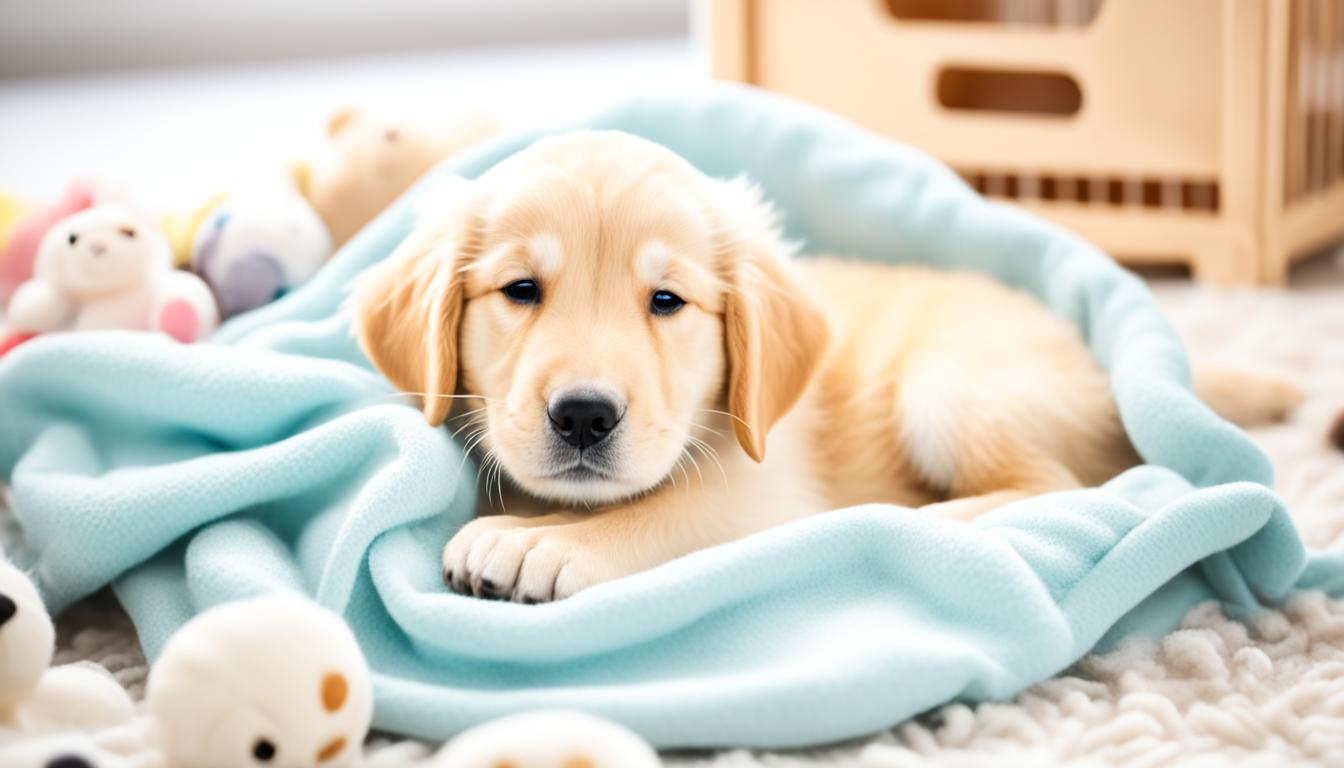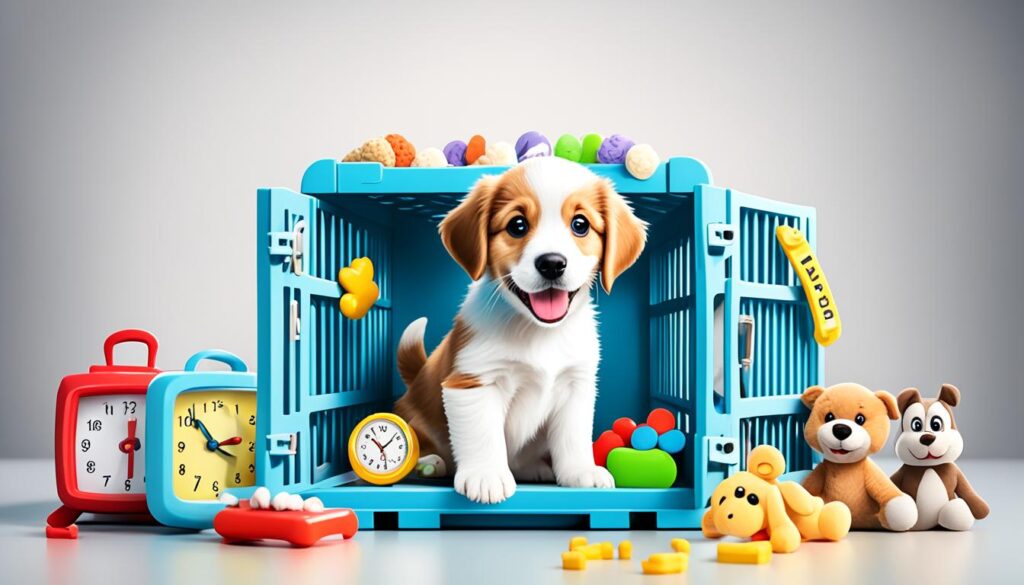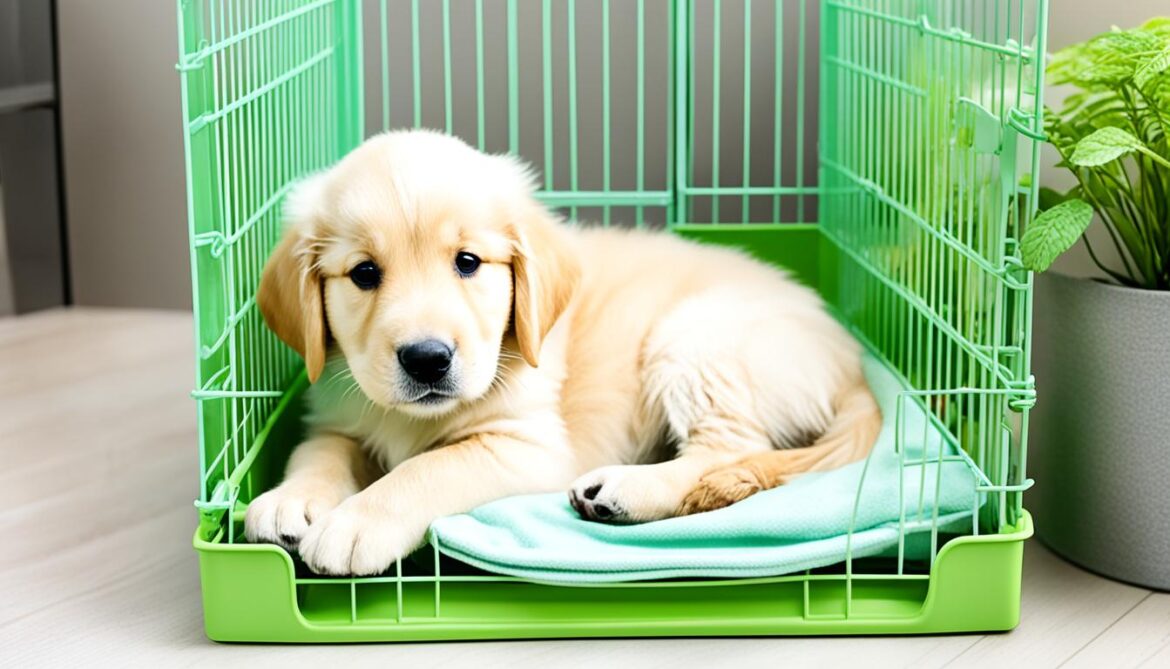Are you bringing a new furry friend into your home? Or maybe you’re looking for better ways to train your current pup? No matter the case, crate training is a crucial aspect of raising a well-behaved and happy puppy. But how do you ensure your crate training efforts are quick, effective, and stress-free for both you and your pup?
In this section, we will explore quick and effective tips for crate training a puppy. Whether you’re a new pet parent or looking to improve your current training methods, these tips will help you create a positive and successful crate training experience for your furry friend.
Key Takeaways:
- Choose the right crate for your puppy’s size and comfort.
- Establish a consistent crate training schedule.
- Introduce your puppy to the crate gradually and with positive reinforcement.
- Use the crate as a valuable tool for potty training.
- Make the crate a cozy and inviting space for your puppy.
Why Crate Training is Important for Puppies
Crate training is a vital aspect of raising a well-behaved and happy puppy. It offers numerous benefits that contribute to their overall development and provides a safe and secure environment for them to thrive in.
- Safe Space: A crate serves as a den-like sanctuary where your puppy can feel secure and comfortable. It becomes their personal space, alleviating anxiety and promoting relaxation, especially during times of stress like thunderstorms or when visitors are present.
- Potty Training: Crate training plays a crucial role in potty training your puppy. By confining them to a crate, you encourage them to develop bladder and bowel control, as puppies instinctively avoid soiling their sleeping area.
- Behavioral Development: Crate training aids in promoting good behavior in puppies. It teaches them self-control and reduces the likelihood of destructive behavior, such as chewing on furniture or excessive barking.
- Independence: By crate training your puppy, you foster their independence and reduce separation anxiety. They learn to spend time alone and become accustomed to being in their crate without feeling distressed or anxious.
“Crate training is not only about creating a designated space for your puppy, but it also enhances their well-being, facilitates potty training, shapes their behavior, and promotes independence.”
By crate training your puppy, you establish a foundation for a harmonious relationship and set them up for a lifetime of good behavior and comfort. It is essential to approach crate training with patience, consistency, and positive reinforcement to ensure a positive and successful experience for both you and your puppy.
Benefits of Crate Training a Puppy
| Benefit | Description |
|---|---|
| Safe Space | Creates a secure and calming environment where puppies can seek refuge. |
| Potty Training | Encourages bladder and bowel control, helping to establish a consistent routine. |
| Behavioral Development | Reduces destructive behavior and promotes self-control and good manners. |
| Independence | Teaches puppies to be comfortable spending time alone and prevents separation anxiety. |
Investing time and effort into crate training your puppy yields long-term benefits and fosters a happy and well-adjusted canine companion. In the next section, we will delve into choosing the right crate for your puppy to ensure their comfort and safety.
Choosing the Right Crate for Your Puppy
When it comes to puppy crate training, selecting the right crate is essential for your furry friend’s comfort and safety. In this section, we’ll explore different crate types, sizes, and materials to help you make an informed decision. By choosing the perfect crate, you can create a secure and inviting space for your puppy to relax and learn.
Types of Crates
There are several types of crates available, each with its own advantages:
- Wire Crates: These crates offer excellent ventilation and visibility, allowing your puppy to see their surroundings.
- Plastic Crates: Ideal for travel, plastic crates provide a cozy and den-like environment that can help your puppy feel safe and secure.
- Soft-Sided Crates: These lightweight crates are convenient for travel and can be easily folded and stored when not in use.
Choosing the Right Size
Ensuring the crate is the correct size for your puppy is crucial. A crate that is too small will be uncomfortable, while a crate that is too large may not create the desired cozy environment. Consider the adult size of your puppy’s breed and choose a crate that allows them to comfortably stand, turn around, and lie down.
Materials
When it comes to material, durability and ease of cleaning should be a priority. Here are some common crate materials:
- Wire: Wire crates are sturdy, easy to clean, and provide excellent ventilation.
- Plastic: Plastic crates are durable, lightweight, and often come with removable trays for easy cleaning.
- Fabric: Soft-sided crates are lightweight and portable, but ensure the fabric is strong and resistant to chewing.
Keep in mind that puppies may chew on the crate, especially during the teething stage. Choosing a crate made from durable materials will withstand their adorable mischief.

Now that you have a better understanding of the different crate types, sizes, and materials, you can make an informed decision for your puppy’s crate training journey. Remember, the right crate will provide a secure and comfortable space where your puppy can thrive.
Establishing a Crate Training Schedule
In order to crate train your puppy effectively, it is crucial to establish a consistent crate training schedule. A well-structured routine will help your puppy develop positive associations with the crate and adapt to their new environment with ease.
Here are some guidelines to help you create a crate training schedule that works:
- Introduce Short Sessions: Begin by introducing short crate sessions, gradually increasing the duration over time. This will help your puppy feel more comfortable and prevent them from becoming overwhelmed.
- Create a Daily Routine: Set specific times for meals, potty breaks, playtime, and crate training sessions. This will provide structure and predictability for your puppy, making the training process more successful.
- Consistency is Key: Stick to the schedule as much as possible. Consistency will help your puppy understand what is expected of them and establish a routine that they can rely on.
“Consistency is key when establishing a crate training schedule for your puppy.”
Keep in mind that every puppy is different, and it may take some trial and error to find a schedule that works best for your furry friend. Be patient and adaptable, making adjustments as needed.
“Sticking to a consistent crate training schedule will help your puppy develop positive associations with the crate and adjust to their new environment.”
Introducing Your Puppy to the Crate
When it comes to crate training your puppy, introducing them to the crate in a positive and comfortable manner is key. By following simple techniques and utilizing gradual acclimation, you can create a pleasant experience that will make your puppy feel safe and secure in their new space.
Positive Reinforcement
Start by associating the crate with positive experiences. Use treats, praise, and rewards to encourage your puppy to explore and enter the crate willingly. Place treats near the crate entrance and gradually move them inside to encourage your puppy to go further into the crate. Repeat this process multiple times throughout the day, ensuring that your puppy feels rewarded for their brave steps.
Gradual Acclimation
Once your puppy is willingly entering the crate, it’s time to help them adjust to being inside for longer periods. Begin by closing the crate door for short intervals while your puppy is inside, gradually increasing the time as they become comfortable. Stay nearby, offering reassurance and positive reinforcement throughout the process. Remember, the goal is to help your puppy associate the crate with feelings of security and relaxation.
Remember to be patient and understanding during this process. Each puppy is unique and may require more or less time to adjust. Adapt your approach accordingly to ensure a successful crate training journey.
Creating a Comfortable Space
Make the crate a cozy and inviting space for your puppy. Line it with a comfortable blanket or bedding, ensuring that it’s clean and free from any potential hazards. You can also place a familiar scent, such as a worn t-shirt or a toy, inside the crate to provide comfort and familiarity.
Here’s a helpful tip: Avoid placing the crate in an isolated area or a noisy part of your home. Find a location where your puppy can still feel connected to the family and observe their surroundings without feeling overwhelmed.
Remember, patience and consistency are key when introducing your puppy to the crate. By using positive reinforcement, gradual acclimation, and creating a comfortable space, you’ll help your puppy develop positive associations with their crate and set them up for successful crate training.

Next, we’ll explore how crate training can assist with puppy potty training. Stay tuned for Section 6: Puppy Potty Training with Crate.
Puppy Potty Training with Crate
Incorporating crate training into your puppy’s potty training routine can be incredibly beneficial. Not only will it help prevent accidents and maintain a clean home environment, but it will also instill good habits in your furry friend. By using the crate as a tool for potty training, you can set your puppy up for success and make the process as smooth as possible.
How Crate Training Helps with Puppy Potty Training
When it comes to potty training, consistency is key, and the crate can play a vital role in establishing a routine. By confining your puppy to the crate when you’re unable to supervise them, you’re preventing any accidents from occurring in the house. This teaches your puppy to hold their bladder and bowels until they’re taken outside, promoting good bathroom habits.
The crate also serves as a safe and comfortable den-like environment for your puppy. Dogs have a natural instinct to keep their den clean, so when the crate is appropriately sized, your puppy will be less likely to eliminate inside it. This encourages them to hold it until they’re let out of the crate, making potty training more effective in the long run.
Tips for Using the Crate in Puppy Potty Training
Here are some tips to make crate training a valuable aid in your puppy’s potty training journey:
- Start introducing your puppy to the crate gradually. Make it a positive experience by associating the crate with treats, toys, and praise.
- Ensure the crate is the right size for your puppy. It should provide enough space for them to stand, lie down, and turn around comfortably, but not too much room for them to eliminate in one corner and sleep in another.
- Establish a regular schedule for taking your puppy outside to eliminate. Consistency and routine are essential for successful potty training.
- Use verbal cues, such as “go potty” or “do your business,” when taking your puppy outside to reinforce the desired behavior.
- Avoid leaving your puppy in the crate for extended periods. Puppies have limited bladder control, and confining them for too long can lead to accidents. Gradually increase crate time as your puppy becomes more comfortable and reliable with potty training.
Remember, potty training takes time and patience. Be consistent with your crate training routine, and your puppy will learn to associate the crate with a safe and comfortable space while developing good potty habits.
Conclusion
In conclusion, crate training is an invaluable tool for teaching your puppy essential skills and creating a harmonious home environment. By implementing the crate training tips and techniques discussed in this article, you can embark on a successful crate training journey with your furry friend.
Crate training not only provides a safe and secure space for your puppy but also helps with potty training, reducing anxiety, and promoting good behavior. It allows your puppy to have their own den-like retreat while also teaching them to be comfortable spending time alone.
Remember to choose the right crate size, introduce your puppy gradually, and establish a consistent training schedule. Utilize positive reinforcement, treats, and toys to make the crate a positive and inviting space for your puppy.
With patience, consistency, and love, crate training can be a rewarding experience for both you and your puppy. Soon enough, your furry companion will view their crate as a cozy haven, and you’ll have peace of mind knowing they are safe and happy in their own special space. Start crate training your puppy today and enjoy the benefits it brings to your lives!
FAQ
How do I crate train a puppy?
To crate train a puppy, start by introducing them to the crate gradually. Make it a positive experience by using treats and praise. Gradually increase the amount of time the puppy spends in the crate, and always ensure they have enough space, comfort, and toys. Avoid using the crate as a punishment, and establish a consistent schedule for meals, potty breaks, and playtime.
What are the benefits of crate training a puppy?
Crate training offers several benefits, including providing a safe and secure space for your puppy when you can’t supervise them. It aids in potty training by teaching the puppy to hold their bladder and bowel movements. Crate training also helps prevent destructive behavior, promotes good manners, and provides your puppy with a sense of comfort and security.
How do I choose the right crate for my puppy?
When selecting a crate for your puppy, consider their size, breed, and future growth. Choose a crate that allows them enough room to stand, turn around, and lie down comfortably. Opt for a crate with durable materials and secure locks. If you have a larger breed, choose a crate with a divider panel to adjust the space as your puppy grows.
Why is establishing a crate training schedule important?
Establishing a crate training schedule helps your puppy develop a routine and creates a sense of predictability. Consistency is key during crate training, as it helps your puppy understand when to expect meals, potty breaks, playtime, and rest. A schedule also aids in potty training by establishing regular bathroom breaks.
How do I introduce my puppy to the crate?
Introduce your puppy to the crate gradually. Start by placing treats or toys inside the crate to entice them to explore. Allow them to enter the crate voluntarily and reward them with praise and treats. Gradually increase the time they spend in the crate, while keeping it a positive experience. Create a cozy and inviting space with soft bedding and familiar scents to help your puppy feel comfortable.
How can crate training help with puppy potty training?
Crate training can be a valuable tool for puppy potty training. Dogs naturally avoid soiling their sleeping area, so the crate can teach them to hold their bladder and bowel movements until they’re outside. By establishing a consistent routine and using the crate to confine your puppy when unsupervised, you can minimize accidents and establish proper potty habits.
